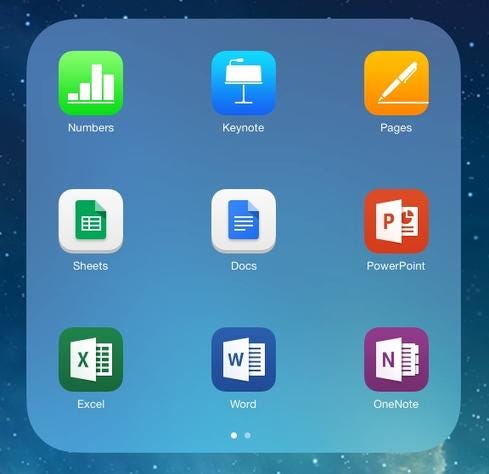Windows Threshold May Merge Windows Phone, RT
Microsoft's upcoming Windows Threshold operating system reportedly will merge Windows Phone and Windows RT into one user interface for ARM-based mobile devices.


Microsoft Office For iPad Vs. iWork Vs. Google
Microsoft Office For iPad Vs. iWork Vs. Google (Click image for larger view and slideshow.)
Since last year, reports have claimed Microsoft officials plan to merge Windows Phone and Windows RT -- among the least popular of all major mobile platforms -- into one operating system. Company execs have sketchily alluded to such a plan without providing any confirmation or concrete details. A new report, however, claims that the next version of Windows, codenamed Threshold, will come in a version for hardware equipped with ARM processors; that is, for Windows Phone and Windows RT mobile devices.
Low-cost, low-energy ARM chips power the vast majority of mobile devices, but Microsoft, whose operating systems traditionally have run on x86-based Intel processors, has been unable to popularize ARM-based versions of Windows. No OEM other than Microsoft currently supports Windows RT. Although Microsoft has recently galvanized support among its smartphone partners, Windows Phone accounted for only 2.5% of the smartphone market in the second quarter of 2014, according to the research firm IDC. Despite these struggles, Microsoft execs maintain Windows has a future on ARM.
[Is time running out for Windows Phone? Read Windows Phone: More High-End Devices Coming Soon.]
Later this fall, Microsoft is expected to publicly preview the next version of Windows for Intel-based devices, but ARM fans reportedly will have to wait until early next year. According to ZDNet's Mary Jo Foley, who has a good track record for pre-release Microsoft information, the ARM-based version of Threshold will be released as a public preview in January or February, and will run on both Windows RT and Windows Phone devices.
The current version of Windows RT includes a water-down desktop UI, which Microsoft has said was necessary to port Office from the desktop version to ARM devices. By early next year, Microsoft is expected to release touch-first versions of Office for Windows, however. Consistent with this expectation, the ZDNet report claims "Threshold" for ARM will not include any desktop interface.
Earlier this summer, Microsoft CEO Satya Nadella said all Windows versions would soon join "into a single, converged [OS] for screens of all sizes," a statement that suggests a Windows Phone-Windows RT merger is indeed coming. In an interview last week, InformationWeek asked Windows Phone director Greg Sullivan about Threshold plans for Windows Phone. He offered only, "The engineering team has been doing prodigious amounts of work," and, "My expectation is that good work will continue."
The Threshold preview expected this fall for Intel devices, meanwhile, reportedly will include two features Microsoft has teased: a Start menu, whose omission was one of Windows 8's most criticized elements, and the ability to run Modern apps in floating windows on the desktop, like legacy apps. According to unconfirmed reports from sources that have reliably reported pre-release information in the past, Threshold will automatically detect what kind of device it is running on. Traditional PCs and notebooks will get a new desktop interface, tablets will get a revamped version of the Modern Start Screen, and two-in-one devices such as the Surface Pro will present a user interface based on whether a keyboard is attached.
Neither the desktop nor tablet interface is expected to include Windows 8's Charms menu, but the desktop UI could include support for virtual desktops like those in OS X's Spaces feature. The fall preview might not include new desktop UI elements that will be included in the final release, according to a report published by the website Neowin, which also said Microsoft is conducting a limited technical preview with corporate customers before launching the public version.
Reports are that Microsoft might make Threshold free to both Windows 7 and 8 users. Microsoft stopped supporting Windows XP earlier this year but has had trouble persuading all users to upgrade; around a quarter of PC users still rely XP, according to Web-tracking firm Net Applications. By making Threshold free to Windows 7 users, Microsoft might avoid repeating this trouble.
It's also unclear if Threshold will be branded as Windows 9. Many expect a new version number, simply because Microsoft needs to distance the next edition from Windows 8's reputation as a flop. Microsoft recently revealed that it will begin deploying new OS features and fixes every month, as it already does with security patches, instead of updating Windows in large chunks every few years. As Foley noted, this approach could mean Microsoft will simply continue updating Threshold in perpetuity, rather than releasing Windows 10, Windows 11, and so on.
Microsoft execs have previously noted that consumers and enterprises respond differently to operating system changes, so it's anyone's guess how customers will react to the new update technique. Some evidence, including Microsoft job postings, indicates the company is preparing a cloud-oriented Windows option that could involve subscriptions, like Office 365.
If the world weren't changing, we might continue to view IT purely as a service organization, and ITSM might be the most important focus for IT leaders. But it's not, it isn't, and it won't be -- at least not in its present form. Get the Research: Beyond IT Service Management report today (free registration required).
About the Author
You May Also Like






